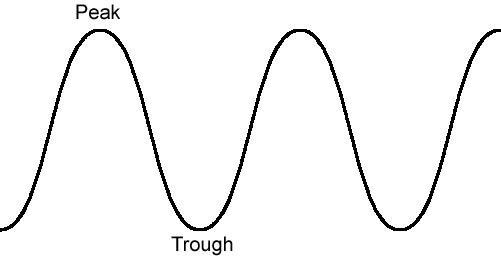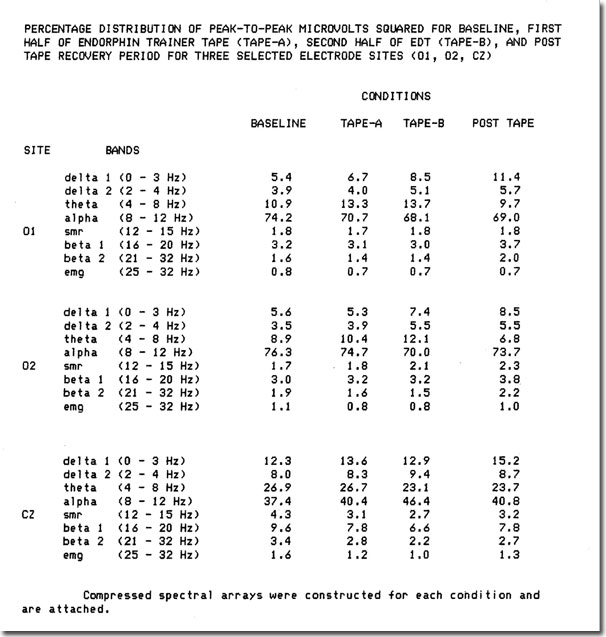Psychoacoustics
delta (0.5 – 4 HZ). Associated with deep levels of relaxation such as sleep
theta (4 – 8HZ). Associated with tranquil states of awareness in which vivid internal imagery can often occur
alpha (8- 12 HZ). Relaxed nervous system, ideal for stress management, accelerated learning and mental imagery
beta (12-30 HZ). Associated with waking/alert states of awareness k-complex (30 – 35HZ). Clarity and sudden states of integration, the “ah-ha experience”
super high beta (35 – 150 HZ). Psychodynamic states of awareness
1. Delta waves: the lowest frequency wave, common during deep sleep
2. Theta waves: found during earlier sleep stages
3. Alpha waves: found during relaxed states like meditation
4. Beta waves, common during typical wakefulness
2. Theta waves: found during earlier sleep stages
3. Alpha waves: found during relaxed states like meditation
4. Beta waves, common during typical wakefulness
Delta is in the 0.5 – 4.0 HZ range and it is associated with deep sleep with no awareness of the self. However, certain individuals with highly developed nervous systems have reported a deep stillness and a relaxed awareness of the self while in delta. Such persons have usually cultivated their nervous systems through such practices as yoga, meditation, etc.
The next level of brain wave activity is theta, which is in the 4 – 8 HZ range. Theta is associated with deep relaxation and profound imaging experiences such as dreams, visions, etc. Furthermore, theta is often linked with the phenomena of self-healing.
From theta we move up into alpha which is associated with mild relaxation. Alpha is in the 8 -14 HZ range, and is often used in such accelerated learning methods as Superlearning. In addition, alpha is utilized in certain types of self-help methods such as cybernetics.
Beta is what we normally think of as waking state, and is in the 14 – 23 HZ range. High beta is in the 23 – 33 HZ range and is associated with heightened states of mental activity. K Complex is in the 33 HZ range, usually occurs in short bursts, and is associated with “aha” experiences when there is sudden insight. Recent research indicates that the brain may generate activity in the neocortex as high as 150 HZ. These brain states are grouped together as high and super high beta.
By targeting certain brain states, it is possible to greatly assist internal activities such as learning, self-healing, the exploration of altered states, etc. While the measurement of brain activity is of paramount importance in our grasp of neurophysiology, the actual mental/emotional and spiritual experiences of the individual are also crucial to our understanding of the brain/mind interface.
The next level of brain wave activity is theta, which is in the 4 – 8 HZ range. Theta is associated with deep relaxation and profound imaging experiences such as dreams, visions, etc. Furthermore, theta is often linked with the phenomena of self-healing.
From theta we move up into alpha which is associated with mild relaxation. Alpha is in the 8 -14 HZ range, and is often used in such accelerated learning methods as Superlearning. In addition, alpha is utilized in certain types of self-help methods such as cybernetics.
Beta is what we normally think of as waking state, and is in the 14 – 23 HZ range. High beta is in the 23 – 33 HZ range and is associated with heightened states of mental activity. K Complex is in the 33 HZ range, usually occurs in short bursts, and is associated with “aha” experiences when there is sudden insight. Recent research indicates that the brain may generate activity in the neocortex as high as 150 HZ. These brain states are grouped together as high and super high beta.
By targeting certain brain states, it is possible to greatly assist internal activities such as learning, self-healing, the exploration of altered states, etc. While the measurement of brain activity is of paramount importance in our grasp of neurophysiology, the actual mental/emotional and spiritual experiences of the individual are also crucial to our understanding of the brain/mind interface.
Basic Acoustics
The following information is a very basic overview of frequencies as the term is used in Psychoacoustics. All sound vibration is comprised of wave patterns. The diagram below shows a typical sine wave (which is the most common wave form used in Psychoacoustics).

A cycle is the distance between peaks. Frequencies are usually read in cycles per second or HZ (Hertz). The higher the frequency the higher the pitch. The normal range of hearing for most people is in the 20 – 20,000 HZ range. A few people hear tones above 20,000 HZ, though it is very rare for someone to hear frequencies below 20HZ.
When frequencies are used to “entrain” the brain into an altered state there are numerous possible strategies. An important thing to remember is that most people cannot hear the lower frequencies that are typical of brain wave patterning. For instance, low alpha (with its attendant relaxation) is in the 8 – 9 HZ range, far below the 20HZ threshold of hearing.
One way to get around this is through Differential Signaling. In Differential Signaling two different tones are sent to the brain. For example let us say we send 200 HZ to the left ear and 208 HZ to the right. The difference between the signals is 8HZ which is what the brain will “entrain” to. We also use musical ratios which have been found to be quite effective at altering awareness.
Another strategy, more commonly used on ABR recordings, is to pulse low tones at specific rhythmic pulsations to “entrain” the brain into the desired state. Thus we may pulse any given frequency or tone at 10 cycles per second to achieve an increase in alpha activity. An advantage to this form of entrain-ment is that a person with ear deafness in one ear can still get the “entrainment”, whereas in Differential Signaling they would not.
In terms of brain processing and body image, there is one aspect to frequencies of vital interest in Psychoacoustics. By using different frequencies, it is possible to resonate different areas of the body, thereby activating or triggering emotional/mental activity associated with those areas. The applications to psychotherapy and disciplines involving the body/mind interface are very exciting.
When frequencies are used to “entrain” the brain into an altered state there are numerous possible strategies. An important thing to remember is that most people cannot hear the lower frequencies that are typical of brain wave patterning. For instance, low alpha (with its attendant relaxation) is in the 8 – 9 HZ range, far below the 20HZ threshold of hearing.
One way to get around this is through Differential Signaling. In Differential Signaling two different tones are sent to the brain. For example let us say we send 200 HZ to the left ear and 208 HZ to the right. The difference between the signals is 8HZ which is what the brain will “entrain” to. We also use musical ratios which have been found to be quite effective at altering awareness.
Another strategy, more commonly used on ABR recordings, is to pulse low tones at specific rhythmic pulsations to “entrain” the brain into the desired state. Thus we may pulse any given frequency or tone at 10 cycles per second to achieve an increase in alpha activity. An advantage to this form of entrain-ment is that a person with ear deafness in one ear can still get the “entrainment”, whereas in Differential Signaling they would not.
In terms of brain processing and body image, there is one aspect to frequencies of vital interest in Psychoacoustics. By using different frequencies, it is possible to resonate different areas of the body, thereby activating or triggering emotional/mental activity associated with those areas. The applications to psychotherapy and disciplines involving the body/mind interface are very exciting.


